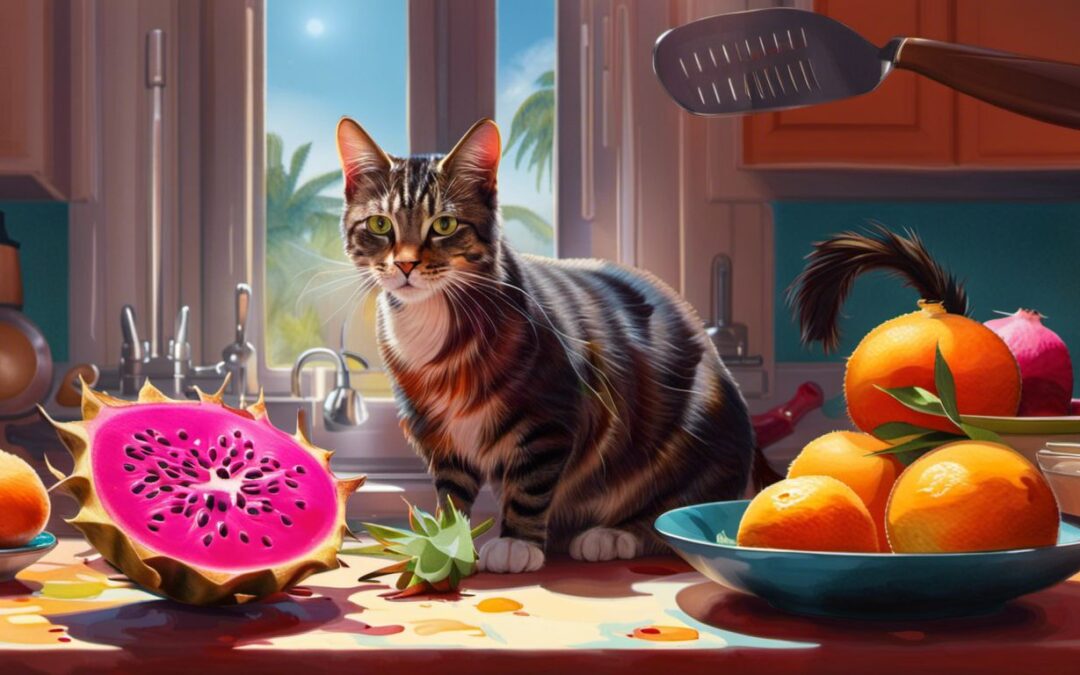Have you ever wondered, “Can Cats Eat Dragon Fruit?” With its vibrant color and unique flavor, dragon fruit, also known as pitaya, is a tropical delicacy enjoyed by humans worldwide.
This blog will provide clear insights into whether this exotic wonder is suitable for your feline friends. Dive in to learn more about incorporating dragon fruit into your cat’s diet without compromising their health!
Key Takeaways
- Dragon fruit can be safe for cats and may provide some health benefits, including aiding digestion, boosting the immune system, and promoting healthier skin and coat.
- However, there are risks to consider when feeding dragon fruit to cats, such as potential digestive issues, allergic reactions, and weight gain if consumed in excess.
- When introducing dragon fruit to your cat’s diet, start with small amounts as a treat and gradually increase the portion size over time. Always monitor your cat for any adverse reactions and consult with a veterinarian before making any significant changes to their diet.
Is Dragon Fruit Safe for Cats?
Dragon fruit can be safe for cats and may even provide some health benefits, but there are also risks to consider when feeding it to your feline friend.
Potential health benefits of dragon fruit for cats
Dragon fruit, also known as pitaya, has a wealth of health benefits for cats. High in fiber, it aids digestion and helps prevent constipation in felines. Vitamins C and E present in the exotic fruit contribute to an improved immune system and healthier skin and coat.
The dragon fruit’s low sugar content makes it safe for consumption even by diabetic cats. Just like its hydrating quality becomes beneficial especially during hot summer months. Essential minerals such as magnesium found in this tropical treat support heart health while its antioxidant properties help combat harmful free radicals thereby promoting overall well-being of your furry friends.
Risks and considerations when feeding dragon fruit to cats
Feeding dragon fruit to cats comes with its fair share of risks and considerations. While it may seem like a healthy and exotic treat, there are a few things to keep in mind before offering it to your feline friend.
First, the high fiber content in dragon fruit can lead to digestive issues such as diarrhea or upset stomachs in some cats. Additionally, allergic reactions are possible, so it’s important to monitor your cat closely after introducing this fruit into their diet.
Lastly, due to the natural sugars found in dragon fruit, feeding too much can contribute to weight gain and potential health problems.
Feeding Dragon Fruit to Your Cat
To introduce dragon fruit to your cat’s diet, start by offering small amounts as a treat and gradually increase the portion size over time.
https://www.youtube.com/watch?v=_1fV99aID6w
Tips for introducing dragon fruit to your cat’s diet
Introduce dragon fruit to your cat’s diet with these helpful tips:
- Start small: Begin by offering a small piece of dragon fruit as a treat or topping for your cat’s regular food.
- Monitor for reactions: Watch for any signs of digestive upset or allergic reactions, such as vomiting or diarrhea. If your cat experiences these symptoms, discontinue feeding dragon fruit immediately and consult your vet.
- Gradual introduction: Slowly increase the amount of dragon fruit you offer over time, allowing your cat’s digestive system to adjust.
- Remove the skin and seeds: Before feeding dragon fruit to your cat, ensure that you remove the skin and any seeds to prevent choking hazards or digestive issues.
- Variety is key: Dragon fruit should not be the sole component of your cat’s diet. It is important to provide a balanced diet that includes other nutritious foods suitable for cats.
- Consult with your vet: Always consult with your veterinarian before introducing any new foods into your cat’s diet. They can provide guidance based on your specific cat’s needs.
Proper portion sizes for cats
When it comes to feeding your cat dragon fruit, it’s important to provide proper portion sizes. While dragon fruit can be a healthy addition to their diet, too much of a good thing can cause digestive issues or even lead to weight gain.
To ensure your cat gets the right amount, start by offering small pieces as a treat and monitor their reaction. If they seem to tolerate it well and enjoy the taste, you can gradually increase the portion size.
Remember, moderation is key when introducing any new food to your feline friend.
Potential Side Effects of Feeding Dragon Fruit to Cats
Feeding dragon fruit to cats may result in potential side effects such as digestive upset, allergic reactions, and weight gain.
Digestive upset
Feeding dragon fruit to cats can potentially lead to digestive upset. Cats have sensitive digestive systems, and introducing a new food like dragon fruit may cause stomach discomfort, diarrhea, or vomiting.
It is important to observe your cat’s reaction after feeding them dragon fruit and consult with your veterinarian if they experience any adverse symptoms.
Allergic reactions
Some cats may have allergic reactions to dragon fruit. These reactions can vary from mild symptoms like itching and sneezing to more severe symptoms such as difficulty breathing or anaphylaxis.
If your cat shows signs of an allergic reaction after eating dragon fruit, it’s important to seek veterinary attention immediately. It’s always a good idea to introduce new foods slowly and monitor your cat for any adverse reactions, especially if they have allergies or sensitivities.
Weight gain
Feeding your cat too much dragon fruit can contribute to weight gain. This exotic fruit is naturally sweet and contains a good amount of sugar, which when consumed in excess, can lead to extra pounds on your furry friend.
It’s important to remember that cats have specific dietary needs, and their main source of nutrition should come from balanced cat food. While small amounts of dragon fruit as an occasional treat may be fine, it’s best to consult with your vet about portion sizes and the overall impact on your cat’s weight.
Conclusion
In conclusion, while dragon fruit can be safely consumed by cats in small portions, it is important to proceed with caution. The potential health benefits and exotic appeal of this fruit may entice cat owners, but it is crucial to consult a veterinarian before introducing any new food into your cat’s diet.
Remember, the well-being and safety of our feline friends should always come first!
FAQs
1. Is dragon fruit safe for cats to eat?
Dragon fruit is generally safe for cats to eat in small amounts as an occasional treat. However, it is important to remove the seeds and skin before offering it to your cat.
2. Are there any health benefits of feeding dragon fruit to cats?
Dragon fruit is a good source of vitamins and minerals such as vitamin C, calcium, and iron. It can provide some nutritional benefits for cats when fed in moderation.
3. Can eating dragon fruit cause any negative effects on cats?
While dragon fruit is not toxic to cats, consuming large amounts or eating the skin or seeds may cause digestive upset such as diarrhea or stomach discomfort. It should be given sparingly and with caution.
4. How should I introduce dragon fruit into my cat’s diet?
If you want to introduce dragon fruit into your cat’s diet, start by offering a small amount as a treat and monitor their reaction. If they show any signs of digestive upset, discontinue feeding it to them.






